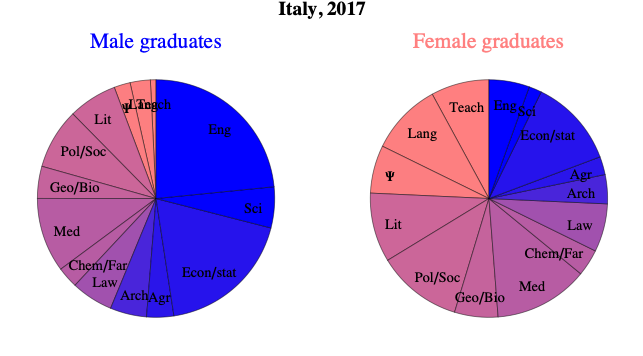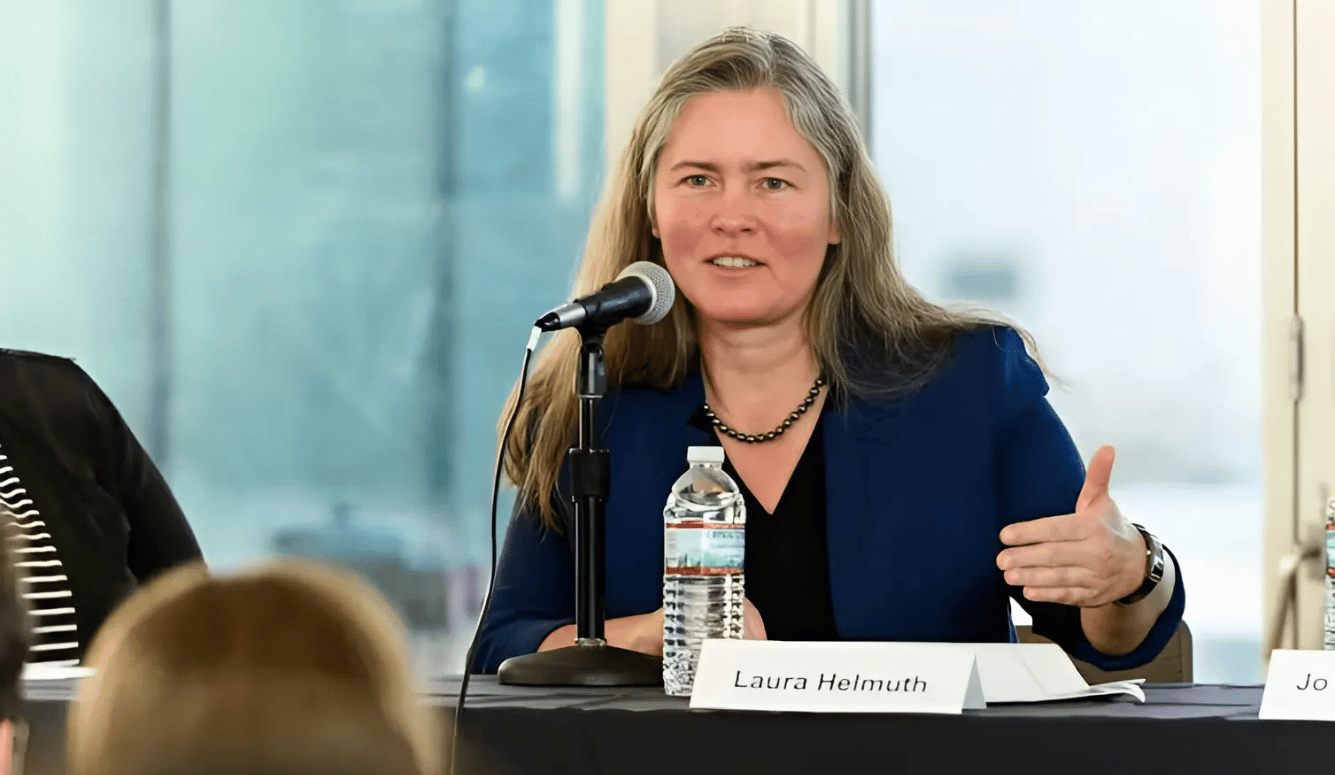Why Are Women Under-Represented in Physics?
Proposing that some gender imbalances in fields like physics might not be due to discrimination is like being a social scientist in the Soviet Union and proposing that some class differences aren’t due to discrimination.

Six months ago CERN hosted a workshop on “High Energy Theory and Gender.” Nearly all the contributors to this and previous workshops on the same topic endorsed the view that gender imbalances in physics, particularly in the higher echelons, are predominantly due to sexual discrimination. The following phrases appeared in the presentations: “men mobilize their masculinity supporting…men in ways that advance careers,” “evaluators tend to favor men,” “scientific quality is a gender social construction,” “practically all women share the same kind of sad and unfair experiences since the beginning of their scientific career,” and physics is an “oppressive ambient.” One attendee claimed that only the military has a higher rate of sexual harassment, although she didn’t say which country’s armed forces she was thinking of.
In an attempt to go beyond mere anecdotes and measure the amount of discrimination, I did a bibliometric analysis using a public database of publications, references, authors and hiring decisions in fundamental physics world-wide over the past 50 years. CERN maintains this database, but nobody had used it for this purpose before. Certainly, none of the hosts of the “High Energy Theory and Gender” workshop had used it to test their claims.
The results that came out of this study did not fit the discrimination narrative. With colleagues, I spent the summer checking the data and exploring ways to present them at the workshop that wouldn’t harm our careers. We joked among ourselves about what would happen to the person giving the presentation, having discovered the fate of other scientists who made similar points. Our findings were scientifically robust, but nobody in our little group wanted to present them. In the end, I decided that I had the least to lose.
So I presented the results, discussed them with colleagues at CERN and tried to convey as sincerely as I could that the final sentence of my talk—“hope to see you again”—was not supposed to be ironic. As predicted, a storm was quickly whipped up on Twitter and elsewhere, misinterpreting my views and even inventing some statements and attributing them to me. CERN issued a press release according to which “everyone is welcome…regardless of…beliefs” and suspended me while investigating whether my 30-minute talk had violated internal rules, such as the “obligation to exercise reserve and tact,” “reserve in expressing personal opinions” and “communications to the public.”
If you are in physics or an adjacent field, I encourage you to sign on to this statement rejecting the statements Alessandro Strumia made at CERN last week.https://t.co/6bPxRRfjsL
— Robert McNees (@mcnees) October 5, 2018
I find it alarming that a scientific organization has rules that restrict free speech using such vague, subjective language. After five months, CERN concluded that it would “not pursue disciplinary proceedings”—to be clear, I have not been charged with violating any of the rules. Despite this, CERN removed all traces of my talk from its website, declaring it “offensive.” As Ben Shapiro says, “facts don’t care about your feelings,” and the claim to be offended is often used by political activists to silence people who don’t subscribe to their views. At some point, CERN removed my name from a physics workshop without telling me and I had to ask to leave.
Daniel Harlow, a physicist at MIT, and some other American academics, have been clamoring for me to be punished on a website/petition called Particles for Justice ever since I gave my talk. Two physicists independently reviewed “Particles for Justice” and discovered what they felt were “unethical misrepresentation,” “misleading citations,” “poor analysis,” and “unscientific attitudes.” They concluded that the “outrage” of the site’s creators and signatories was “misplaced and unsupported by the data they themselves cite.” Particles for Justice also contains personal attacks on me that aren’t supported by the facts. I ignored it until CERN put out a new press release on March 8, announcing that I’d left the organization. A new wave of attacks followed and I decided to put up the slides I’d presented at the talk, as well as an audio recording of the whole thing, on this web site.
I was told that I had grounds for more than one defamation suit, but decided not to sue. I complained to CERN that some personal attacks on me were made by people who included their CERN affiliation after their names and I’m waiting to see whether CERN applies the same rule to them as it did to me. So far, it hasn’t responded.
Data
Bibliometrics is the statistical analysis of scientific papers and their authors. Physicists start writing papers when completing their Ph.D.s and it is at this stage in their academic careers that the first gender differences crop up, known as the “representation gap”: there are roughly four male authors for every female. However, the ratio of male-to-female physicists is not the same in all countries, and it is not positively correlated in each country with that country’s ranking in the Global Gender Gap Index. For example, the percentage of women in theoretical physics and STEM is lower in Europe and the U.S. than it is in India or Iran. This suggests that gender imbalances in physics aren’t caused by gender inequality—if they were, you’d expect them to be higher in less equal countries.
Using citations, it’s possible to build bibliometric indices of scientific merit. The number of (fractionally counted) citations received by authors provides a reasonable indicator of their scientific merit. Data show that, at the moment they’re hired in research or academic posts, female physicists have on average fewer (fractionally counted) papers and citations than their male equivalents. As the careers of physicists progress, the initial representation gap doesn’t change much, and a second difference known as the “productivity gap” appears. This was confirmed by my data. The picture above persists after controlling for confounders, such as the higher average age of male authors.
Some colleagues don’t set much store by bibliometrics and it’s certainly a tool that needs to be used with caution. But the reason it’s used by professional evaluation agencies is because it works. Most of my results, which suggest that sexual discrimination isn’t the cause of the under-representation of women in physics, are consistent with what other experts have found about STEM fields more generally. A recent review summarizes these findings: “The overall picture is one of gender neutrality in GEEMP fields [P is physics], notwithstanding frequent claims to the contrary.”1
Interpretation
Based on the data we found and on previous literature in this field, gender differences in representation and productivity can be interpreted in terms of two main causal factors:
- Gender differences in interests;
- Higher male variability (HMV).
Needless to say, “for every complex natural phenomenon there is a simple, elegant, compelling, wrong explanation” (Thomas Gold) and when dealing with complex systems any simple explanation can easily be inadequate, including explanations that attribute gender disparities exclusively to sexual discrimination. But I believe the data can be explained without invoking sexual discrimination and by focusing instead on the two factors above. Gina Rippon, e.g. in her recent book The Gendered Brain (2019), questions the scientific basis of these factors—which are sometimes dismissed as “neurosexism” and “neurotrash”—but the evidence is quite compelling.
Concerning (1), a meta-review of the scientific literature summarizes the position as follows: “Gender differences in interest and enjoyment of math, coding, and highly systemizing activities are large. The difference on traits related to preferences for ‘people vs. things’ is found consistently and is very large.”2 This difference in interests is consistent with gender differences in preferred academic fields (fig.1 shows the situation in Italy) as well as with gender differences in specializations inside physics, other sciences, the humanities and medicine: the percentage of women is lowest in theoretical physics, philosophy, orthopedic surgery, etc. Students in physics world-wide (both undergraduates and graduates) are roughly 70 percent male—and this doesn’t appear to be due to discrimination. Physics departments are equally open to everybody: men are not offered limousine rides to the department and women don’t need to wear moustaches to get through the door. On the contrary, many departments work hard to attract more female students. However, women are less likely to choose physics in countries with higher levels of gender equality3 and gender differences in interests is most pronounced in Scandinavian countries, where more work has been done than anywhere else in the world to level the playing field between men and women.4 Indeed, some scientific findings suggest average differences in male-female preferences have an innate component. No room to discuss that here, but the work of Simon Baron-Cohen and others suggests that’s true of the “systematizing-empathizing” difference.

Concerning (2), the Higher Male Variability (HMV) hypothesis was first put forward by Charles Darwin in The Descent of Man (1871), along with several other ideas now deemed “offensive.” Psychometric tests indicate that men and women perform, on average, equally well when it comes to different cognitive skills, but men are more common at both the low and the high ends of the distributions. So there’s greater variability among men when it comes to these traits than women. The relevance of HMV for physics and STEM has been discussed by, among others, the former Harvard theorist Lubos Motl, the former Harvard president Lawrence Summers, and by the former Google engineer James Damore. They were all attacked on political grounds, not primarily on scientific grounds. Indeed, in the polemics that followed most experts confirmed the HMV hypothesis, with different groups of scientists reaching the following conclusions: “Males are more variable on most measures of quantitative and visuospatial ability, which necessarily results in more males at both high- and low-ability extremes”;5 “Substantial evidence suggests that the male advantage in mathematics is largest at the upper end of the ability distribution”;6 “On average, male variability is greater than female variability on a variety of measures of cognitive ability, personality traits, and interests. This means men are more likely to be found at both the low and high end of these distributions”7; “Based on the meta-analyses we reviewed and the research on the Greater Male Variability hypothesis, Damore is correct that there are population level differences in distributions of traits that are likely to be relevant for understanding gender gaps at Google.”8 HMV contributes significantly to the representation gap only among those rare authors that produce groundbreaking work in physics.
Experts like these were not invited to the CERN workshop, so it fell to me to bring up their results. My paper with details of my analysis was rejected by arXiv.org, an open access platform, on the basis that it hadn’t been published yet. But arXiv.org is a pre-print bulletin and accepts other pre-prints, including those with politically correct but scientifically incorrect claims about gender. As an alternative, I put my paper online so that those interested could evaluate its correctness in a scientific way.9 I note that the mathematician Prof. Theodore Hill experienced unusual difficulty getting a paper on the HMV published.
CERN and arXiv.org are respected scientific institutions, but hiding “offensive” results is not a particularly scientific approach. Had I falsified the data to show that women are being discriminated against in physics, I have no doubt I would not have got into trouble—and arXiv.org wouldn’t have objected to me putting the paper on its platform.
We Have a Problem
Why are experts on gender differences in STEM not invited to conferences about gender in physics? Why are activists who claim to be advancing the cause of women in STEM falsely portraying the fields as being riddled with discrimination, including widespread sexual harassment, when that’s unlikely to attract more women? Why are scientific findings like the ones made by my colleagues and me described as “discredited” while academic journals in gender studies publish Sokal-like hoaxes? Why do some academics want to forbid scientific research on cognitive differences?10 Why has talking about these topics become so dangerous?

The answer, I think, is the one I put forward in my talk when I anticipated it would get me into trouble. Proposing that some gender imbalances in fields like physics might not be due to discrimination is like being a social scientist in the Soviet Union and proposing that some class differences aren’t due to discrimination. Indeed, in the present cultural and political climate, the shibboleths of identity politics have made certain things unsayable. An ideology that reduces everything to a power struggle between different identity groups is producing needless fragmentation and hostility. Reason and objectivity, once the bedrock of science, are frequently dismissed as tools of systemic oppression.11 Science that contradicts the dominant political narrative is attacked, particularly anything relating to gender. Scientific data about gender, like the ones I found, are deemed to be “offensive” when they challenge beliefs that are held as sacred. I used to hold these beliefs myself and when Larry Summers lost his job at Harvard I was pleased. But the data have forced me to change my mind. Surely, that’s what a good scientist should do?
Despite all the evidence to the contrary, some people, even scientists, cling on to a worldview that makes its adherents feel morally superior. It’s the same mistake the Church made centuries ago, when Enlightenment thinkers cast doubt on sacred religious beliefs. In the past decades many social barriers have been removed: some differences that clearly were due to discriminations have disappeared, while others remain. Attempts to attribute the remaining differences to sexual discrimination lead to the invention of dubious concepts such as invisible unconscious biases, micro-aggressions, nano-aggressions, pico-aggressions, etc. Academia should be a place where difficult topics are meaningfully debated, but scientific research on group psychological differences is now dismissed and attacked12 by those who are determined to defend their ideological positions. But the more that heterodox thinkers are ostracized in academia, the more credibility it will lose.

Many academics embrace the politics of Social Justice, believing it will help the vulnerable rather than create more problems. Diversocrats claims that all cultures are good and attack as “oppressive” the Western culture that ended slavery, introduced universal suffrage, significantly reduced extreme poverty around the world, etc. They don’t want equal opportunities but equal outcomes, which mean positive discrimination based on arbitrary physical characteristic that make those groups they designate as victims more equal than others.
As before in our history, those who claim to be fighting against oppression have become the new oppressors. Some people think that research about group differences is bad because “race science” led to concentration camps; but the Blank Slate point of view (there is no such thing as human nature, all differences are socially constructed, etc.) led to re-education gulags in the Soviet Union and China. Extremism of all kinds leads to human misery. As Solzhenitsyn said, “[I]deology, that is what gives evil-doing its long-sought justification.”
STEM Under Attack
Many colleagues privately consider the Social Justice cultists as minor irritants who should be appeased to avoid trouble. They suggest avoiding sensitive topics and “unethical” scientific research (e.g. those areas likely to produce findings that conflict with social constructivist dogma). While I understand and share their desire to sidestep political conflict, I fear that political activists will not avoid them. This ideology cannot be appeased; its most fanatical adherents claim that science itself is “unethical” because it leads to hierarchies based on competence. This is not a problem that disappears if you ignore it.
The present situation in some U.S. universities has been described by Heather Mac Donald as an unstable cohabitation between “a still serious system centered on the sciences” and an “unserious institution dedicated to the all-consuming crusade against phantom racism and sexism” and she has warned that “STEM fields are under attack.”13 Jordan Peterson confirms this: “STEM disciplines are the next logical attack point.”
The attack on the hard sciences follows the identity politics playbook: STEM is declared to be “hostile ambient” because its demographics differ from table football (equal rigid rows of blue and pink). There are fewer women, so the only explanation must be sexual discrimination. Being apolitical is no longer enough; scientists who apply to many North American universities must now sign “diversity statements,” proclaiming their allegiance to Social Justice ideology. I am in favor of equal opportunities, so in the multiple-choice section designed to weed out racists and sexists I would write that “the most qualified person should get the job,” regardless of his/her gender, race, political orientation, etc. The wrong answer, obviously. Saying that is a “micro-aggression,” apparently.
To get a job, you now have to believe in equality of outcome. If male physicists are more cited than female physicists it must be because physicists are afflicted by “unconscious gender bias” as measured by the Implicit Association Test. CERN hosted a seminar about this, and nobody bothered to ask: Is there evidence that the IAT measures unconscious bias? Is there evidence that unconscious bias is one of the causes of gender gaps in STEM? Empirical science (the best method to avoid falling victim to biases) has no role to play in these debates, even though they are about scientists. It’s as if astrophysicists are being asked to justify themselves to astrologists.
What Can Be Done?
Maybe an institution that welcomes diverse viewpoints can host a workshop about the under-representation of women in STEM where genuine experts are invited and allowed to debate freely with activists. But I’m not optimistic. Some colleagues who wrote to me to express their solidarity dared not sign their names. The physicists who criticized “Particles for Justice” have chosen to remain anonymous for fear of losing their livelihoods. Other colleagues worry that they are not close enough to retirement age to risk speaking out. During a recent seminar about gender and STEM at Sydney University, somebody stressed the relevance of individual scientific quality when it comes to hiring decisions, but did so in an anonymous paper. Critics of gender politics in science are increasingly hiding behind the cloak of anonymity to avoid career repercussions. Now, thankfully, those few professors who have dared to take a stand—Jordan Peterson, Janice Fiamengo, Gad Saad, and a handful of others, as well as a few courageous journalists—are receiving an encouraging level of attention. My expectation is that this political movement will fade away in a decade or so. We can only hope.
Alessandro Strumia is a theoretical physicist at the University of Pisa and a former guest professor at CERN.
References
1 S.J. Ceci, D.K. Ginther, S. Kahn, W.M. Williams, “Women in academic science: A changing landscape”, Psychological Science in the Public Interest, 15 (2014) 75.
2 R. Su, J. Rounds, P.I. Armstrong, “Men and things, women and people: A meta-analysis of sex differences in interests”, Psychol. Bull. 135 (2009) 859. See also S. Pinker, “The Science of Gender and Science”, talk at Harvard on 22/4/2005.
3 G. Stoet, D.C. Geary, “The Gender-Equality Paradox in Science, Technology, Engineering, and Mathematics Education”, Psychological Science 29 (2018) 581.
4 See e.g. M.E. Giolla, P.J. Kajonius. “Sex differences in personality are larger in gender equal countries: Replicating and extending a surprising finding”, Int. J. Phychol (2018). A. Falk, J. Hermle, “Relationship of gender differences in preferences to economic development and gender equality”, Science 19 (2018).
5 D.F. Halpern, C.P. Benbow, D.C. Geary, R.C. Gur, J.S. Hyde, M.A. Gernsbacher, “The science of sex differences in science and mathematics”, Psychological Science in the Public Interest, 8 (2007) 1.
6 Ibid.
7 S. Stevens, J. Haidt, “The Google Memo: What Does the Research Say About Gender Differences?”, Heterodox Academy.
8 Ibid.
9 A. Strumia, “Biblio-metric analysis of gender issues in fundamental physics”. Some results have been reproduced by others.
S. Hossenfelder, “Do women get fewer citations than men?”, talk at Chapman University, 2018/11/29.
10 N. Carl, “ How Stifling Debate Around Race, Genes and IQ Can Do Harm”, Evol. Psy. Science 4 (2018) 339. N. Carl was attacked for trying to debate the issue.
11 S.R.C. Hicks, “Explaining post-modernism”.
12 N. Carl, “ How Stifling Debate Around Race, Genes and IQ Can Do Harm”, Evol. Psy. Science 4 (2018) 339. N. Carl was attacked for trying to debate the issue.
13 H. Mac Donald, “The diversity delusion”; “How Identity Politics Is Harming the Sciences”.











